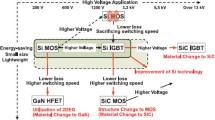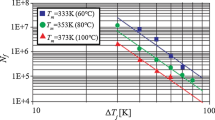Abstract
Semiconductor materials keep occupying an excellent technological position for their importance in building integrated electronic systems. Semiconductor bridge (SCB) with N-type phosphorus-doped silicon material is a new generation of ignition device developed by semiconductor integrated circuit technology. A thermoelectrical model of the ignition device is established in this paper with the consideration of the external capacitor discharge circuit of SCB. The results reveal the thermal properties and electrical properties of the semiconductor device. The time evolution of electric field, current density and temperature distribution during the transient heating process are analyzed. In particular, the temperature distributions of the device show an obvious uneven melting phenomenon; ranging from room temperature to the melting point, the peak temperature points of the SCB transfer versus time, from the edges (0–1.78 ns) to the middle of the bridge (1.78–2.74 ns). The proposed model with specific heavily doped semiconductor material shows that the vaporization fronts tend to originate at the middle of the bridge, rather than the edges. An analysis on the relationship between thermal field and electrical field is conducted, demonstrating that the changes of temperature peak points in SCB are highly relevant to the “flow around” phenomenon in the uneven current density distribution.











Similar content being viewed by others
References
Deen MJ, Pascal F (2006) Electrical characterization of semiconductor materials and devices—review. J Mater Sci Mater Electron 17:549–575
Fortunato E, Barquinha P, Martins R (2012) Oxide semiconductor thin-film transistors: a review of recent advances. Adv Mater 24:2945–2986
Bickes Jr RW, Schwarz AC (1987) Semiconductor bridge (SCB) igniter. U.S. Patent No. 4708060
Lindsay A, Anderson C, Slikboer E, Shannon S, Graves D (2015) Momentum, heat, and neutral mass transport in convective atmospheric pressure plasma–liquid systems and implications for aqueous targets. J Phys D Appl Phys 48:424007
Jones KA, Chow TP, Wraback M, Shatalov M, Sitar Z, Shahedipour F, Tompa GS (2015) AlGaN devices and growth of device structures. J Mater Sci 50:3267–3307. https://doi.org/10.1007/s10853-015-8878-3
Holmberg VC, Helps JR, Mkhoyan KA, Norris DJ (2013) Imaging impurities in semiconductor nanostructures. Chem Mater 25:1332–1350
Kumar B, Kaushik BK, Negi YS (2014) Perspectives and challenges for organic thin film transistors: materials, devices, processes and applications. J Mater Sci Mater Electron 25:1–30
Rebohle L, Prucnal S, Skorupa W (2016) A review of thermal processing in the subsecond range: semiconductors and beyond. Semicond Sci Tech 31:103001
Alì G, Romano V (2017) Existence and uniqueness for a two-temperature energy-transport model for semiconductors. J Math Anal Appl 449:1248–1264
Masolin A, Bouchard PO, Martini R, Bernacki (2013) Thermo-mechanical and fracture properties in single-crystal silicon. J Mater Sci 48:979–988. https://doi.org/10.1007/s10853-012-6713-7
Benson DA, Larsen ME, Renlund AM, Trott WM, Bickes RW Jr (1987) Semiconductor bridge: a plasma generator for the ignition of explosives. J Appl Phys 62:1622–1632
Buniatyan VV, Aroutiounian VM (2007) Wide gap semiconductor microwave devices. J Phys D Appl Phys 40:6355
Kim JU, Park CO, Park MI, Kim SH, Lee JB (2002) Characteristics of semiconductor bridge (SCB) plasma generated in a micro-electro-mechanical system (MEMS). Phys Lett A 305:413–418
Lindsay AD, Graves DB, Shannon SC (2016) Fully coupled simulation of the plasma liquid interface and interfacial coefficient effects. J Phys D Appl Phys 49:235204/1–235204/9
Cecchi S, Etzelstorfer T, Müller E et al (2013) Ge/SiGe superlattices for thermoelectric energy conversion devices. J Mater Sci 48:2829–2835. https://doi.org/10.1007/s10853-012-6825-0
Lee KN, Park MI, Choi SH, Park CO, Uhm HS (2002) Characteristics of plasma generated by polysilicon semiconductor bridge (SCB). Sens Actuators A 96:252–257
Hawks SA, Finck BY, Schwartz BJ (2015) Theory of current transients in planar semiconductor devices: insights and applications to organic solar cells. Phys Rev Appl 3:044014/1–044014/13
Gupta D, Hong Y (2010) Understanding the effect of semiconductor thickness on device characteristics in organic thin film transistors by way of two-dimensional simulations. Org Electron 11:127–136
Groves C (2016) Simulating charge transport in organic semiconductors and devices: a review. Rep Prog Phys 80:026502
Mauri A, Sacco R, Verri M (2015) Electro-thermo-chemical computational models for 3D heterogeneous semiconductor device simulation. Appl Math Model 39:4057–4074
Sverdlov V, Ungersboeck E, Kosina H, Selberherr S (2008) Current transport models for nanoscale semiconductor devices. Mater Sci Eng R 58:228–270
Kim JD, Koo JG, Nam KS (1997) Two-dimensional modelling for the current density distribution in a heavily doped semiconductor resistor. Int J Electron 82:19–26
Marx KD, Bickes Jr RW, Wackerbarth DE (1997) Characterization and electrical modeling of semiconductor bridges. SAND97-8246 UC-70
Nisar UA, Ashraf W, Qamar S (2016) A splitting scheme based on the space–time CE/SE method for solving multi-dimensional hydrodynamical models of semiconductor devices. Comput Phys Commun 205:69–86
Kim J, Nam KS, Jungling KC (1997) Plasma electron density generated by a semiconductor bridge as a function of input energy and land material. IEEE Trans Electron Devices 44:1022–1026
Liu MF, Zhang XB (2012) Temperature distribution and discharge modeling of a semiconductor bridge. IEEE Trans Plasma Sci 40:16–21
Chen J, Hua XF, Zhang XB (2017) Two-dimensional numerical simulation of thermo-electric coupling model in semiconductor bridge ignition system. Int J Heat Mass Transf 113:195–202
Stratton R (1972) Semiconductor current-flow equations (diffusion and degeneracy). IEEE Trans Electron Devices 19:1288–1292
Grasser T, Tang TW, Kosina H, Selberherr (2003) A review of hydrodynamic and energy-transport models for semiconductor device simulation. Proc IEEE 91:251–274
Gummel HK (1964) A self-consistent iterative scheme for one-dimensional steady state transistor calculations. IEEE Trans Electron Devices 11:455–465
Stodtmann S, Lee RM, Weiler CKF, Badinski A (2012) Numerical simulation of organic semiconductor devices with high carrier densities. J Appl Phys 112:114909
Yuan YR, Liu YX, Li CF, Sun TJ, Ma LQ (2016) Analysis on block-centered finite differences of numerical simulation of semiconductor device detector. Appl Math Comput 279:1–15
Savovic S, Djordjevich A (2012) Finite difference solution of the one-dimensional advection–diffusion equation with variable coefficients in semi-infinite media. Int J Heat Mass Transf 55:4291–4294
Lanz T, Bonmarin M, Stuckelberger M, Schlumpf C, Ballif C, Ruhstaller B (2013) Electrothermal finite-element modeling for defect characterization in thin-film silicon solar modules. IEEE J Sel Top Quant 19:1–8
Köck H, Eiser S, Kaltenbacher M (2016) Electrothermal multiscale modeling and simulation concepts for power electronics. IEEE Trans Power Electron 31:3128–3140
Vergura S, Acciani G, Falcone O (2012) A finite-element approach to analyze the thermal effect of defects on silicon-based PV cells. IEEE Trans Ind Electron 59:3860–3867
Yuan JS, Liou JJ (1998) Semiconductor device physics and simulation. Springer, New York
Author information
Authors and Affiliations
Corresponding author
Ethics declarations
Conflict of interest
The authors declare that they have no conflict of interest.
Rights and permissions
About this article
Cite this article
Chen, J., Zhang, X. Investigations of electrical and thermal properties in semiconductor device based on a thermoelectrical model. J Mater Sci 54, 2392–2405 (2019). https://doi.org/10.1007/s10853-018-3014-9
Received:
Accepted:
Published:
Issue Date:
DOI: https://doi.org/10.1007/s10853-018-3014-9




